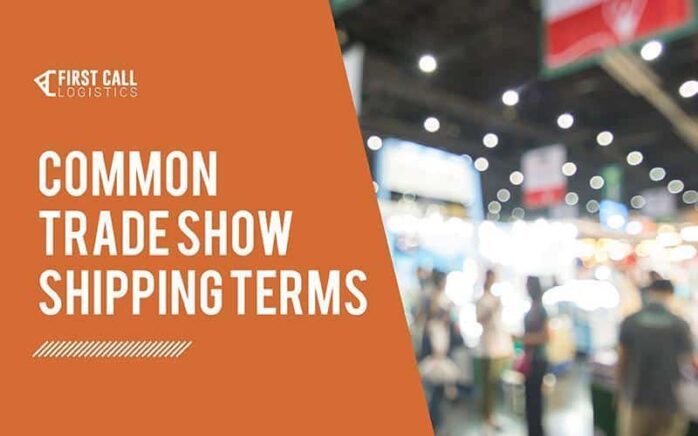Common Trade Show Shipping Terms

Trade shows are exciting opportunities to connect with business associates and potential clients and to learn about innovations in your industry. As we explained in a recent post, trade shows come with a unique set of logistical challenges. To navigate these requirements, it’s helpful to understand some of the most common trade show shipping terms.
Shipping Your Freight
Inbound Shipment: As you may have guessed, this term describes freight arriving at a trade show. The venue will contract someone to receive your shipment and schedule it for delivery to your space on the show floor.
Move-In: Inbound shipments must arrive during move-in, the designated time for the arrival and set up of exhibits at a trade show.
Outbound Shipping: At the close of a trade show, your carrier will pick up your freight to be moved to its next destination.
Move-Out: Similar to move-in, move-out is the time specified for exhibits to be broken down and removed from the exhibit space.
Direct-to-Show Shipping: Rather than shipping freight to an advance warehouse for pre-show storage, freight is shipped directly to the trade show venue.
Forced Freight: If you leave anything on the show floor, it will be categorized as forced freight. Often this freight will be moved to an off-site warehouse until you arrange the return logistics.
Target Date: Trade show organizers provide a date by which freight must arrive. It’s important that carriers meet this target date to avoid off-target fees.
Drayage: Drayage describes moving freight short distances by ground. In the case of trade show shipping, this may involve moving freight from an advance warehouse to the exhibit venue by van, for example.
Material Handling Agreement: This is the means by which shippers authorize drayage services.
Common Carriers: Common carriers typically move freight for multiple clients at a time. This system operates similarly to other less-than-truckload (LTL) freight. The carrier picks up your freight, consolidates it with that of other customers, and delivers it on an optimized route.
Freight Forwarders: Freight forwarders are intermediaries who use their partnerships with various shipping companies to negotiate better rates for customers. They can be especially helpful with international shipping because they can provide support with customs.
Storing Your Freight
Advance Warehouses: Advance warehouses provide pre-show storage for exhibitors. Check with trade show organizers to see if they provide any free storage.
Marshalling Yards: Marshalling yards are the hubs for inbound and outbound shipments at trade shows. This is the space where freight is checked in and out by carriers.
Exhibit Storage Services: Logistics companies can arrange storage for exhibit materials before or between trade shows.
Documenting Your Shipment
Pro Number: Common carriers assign each shipment a unique number that is printed on the bill of lading.
Bill of Lading: The bill of lading catalogs the details of a shipment, including the goods, their destination, and any special handling instructions.
Packing List: Each shipment should have a complete list of its contents. This way upon the shipment’s arrival, the receiver can check what arrived against what was ordered.
Dimensional Weight: The dimensional weight refers to the volume of a shipment as opposed to its weight. Dimensional weight is calculated by multiplying the length, width, and height of a shipment and dividing it by a factor. The factor differs for domestic and international freight as well as for air and land transportation.
Release Forms: When it’s time for an exhibitor to remove their property, the organization running a trade show will issue a release form allowing its removal.
Labels: Inbound and outbound shipments should have clear, visible labels on them to ensure proper direction and handling.
Insurance and Coverage Terms
Declared Value Insurance: Upon booking with a carrier, you must declare the value of your freight. The carrier provides insurance for a fee. The fee varies depending on whether you’re shipping LTL or full truckload.
Corporate Rider Policy: In contrast, a corporate rider policy is part of the larger insurance policy covering your office equipment. Declared value insurance typically is used to offset this policy’s high deductibles. It is required by most storage facilities.
Terms for Penalties and Fees
Free on Board (FOB): This term refers to specifying the place at which you begin paying shipping charges for your freight.
Fuel Surcharge Fees: As fuel prices continue to fluctuate dramatically, carriers try to account for this with fuel surcharge fees. Each company can determine its own way of calculating this fee, so check with your carrier ahead of time.
Off-Target Fees: Some trade shows are aiming to increase the efficiency of inbound and outbound shipments through a system of fees. The idea is to move exhibits in order of size with the largest exhibits coming in first and leaving last. Exhibitors are assigned a window for the arrival and departure of freight. If they miss that window, they’re charged a fee for being off-target.
Overtime Charges: These charges apply when you can’t identify the time at which your freight was removed from the exhibition space.
Waiting-Time Fees: When you arrange your carrier’s pickup time, you identify a window of time for the pickup to occur. However, if the carrier must wait beyond that window to pick up your freight, they may charge you a fee.
Partner with First Call for Your Trade Show Shipping and Storage Needs
Partnering with the right 3PL can simplify navigating the complex world of trade show shipping. Learn how First Call Logistics can leverage our experience and expertise to make your trade show shipping a success. Contact our team today.
Streamline Delivery with Flexible Storage Solutions
Speedy delivery is crucial to any growing business. First Call’s Warehousing & Distribution Services can help establish resilient supply chains, deliver products on time and achieve long-term business goals.
More Resources on Warehousing and Distributions Solutions:
Get the latest supply chain news and updates directly to your inbox.
